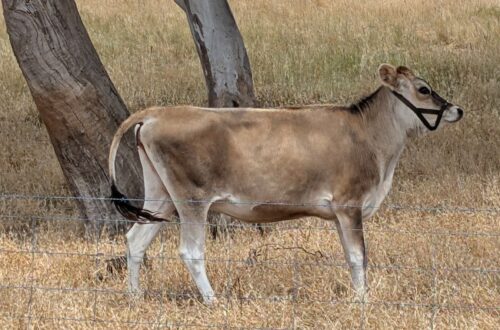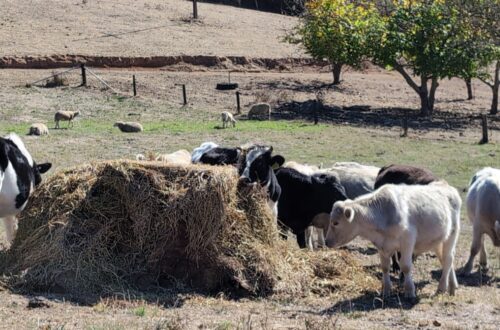
Our first Cattle
Our journey into the world of cattle began on the humble grounds of our rental property, before the dream of our own acreage turned to reality. When we inked the lease, the owner granted us the freedom to introduce a handful of livestock. Yet, a caveat lingered in the air—a neighbor was entrusted with the land for his sheep, for the first year however the owner said he is happy for us to share or wait till the year was up and take over the full management of the land.
Passing of time and new arrivals
A year passed, spent observing cautiously as we hesitated to disturb the neighbors’ flock. When the time came to renew our lease for a second year, we approached the owner with newfound excitement: our decision to introduce 2 Holstein Friesian steers. It might have seemed unconventional, as Holsteins are typically renowned dairy breeds with mentions of smaller eye muscles and lesser fat retention. However, for me, grappling with high-fat intolerance, they represented a hopeful experiment to observe my body’s reaction and the weight they would yield.
In our pursuit of what Lanky terms “steak seeds,” we located a local dairy offering Holstein Friesians. Navigating the unfamiliar realm of cattle ownership involved obtaining a PIC number and delving into numerous inquiries about their care. Despite having a basic understanding of feeding and herding, my direct involvement with cattle had been limited to tending to poddy calves during my high school years.
The arrival of the two young steers, their soft bellows echoing from the back of a horse float, marked a new chapter at the ages of 3 and 4 months. The seller confirmed they were weaned but suggested keeping a bottle and formula on standby, just in case. Thus commenced our education—an unassuming initiation shaped by sparse advice from the seller, which briefly touched upon butchering age and the potential for expanding our herd.

Knowledge shared between community
In the tradition of tight-knit communities, seasoned locals generously imparted their wealth of knowledge upon us novices. They guided us through the intricacies of drenching, taught us the art of supplementing when the grass took on a yellowish hue, and provided insights on bidding farewell to our bovine companions at the optimal age of 18-24 months—a delicate balance between time and yield.
beckoning of the bellows
However, our journey wasn’t devoid of challenges. Our spirited boys, the escape artists, sought out the distant calls of neighboring cows, unraveling mysteries concealed in loose fencing. Collars adorned their necks as a precautionary measure—a symbolic commitment to guiding them back home.

k9 vs bovine
In recent weeks, we’ve faced a new challenge: an unexpected menace from the neighbor’s dogs. A foster dog, acting as a mischievous mentor to its new companions, disrupted the once-tranquil ambience of our pastoral haven. A calamity ensued when the rogue canine claimed a neighbor’s sheep, prompting our daily vigilance to detain the culprit and protect both our livestock and the misguided canine soul.
The cows proved intolerant of being chased and nipped at, and the offending canine quickly learned to evade a few kicks.
farewell to the steers.
Now that the Holsteins are 2 years old, we have scheduled them with the local butcher. We’ve provided them with the best life possible, and in a fortnight, we’ll bid them farewell and express gratitude for the bounty they’ve provided us.

During the initial phase of cattle ownership, we’ve had the opportunity to adjust and learn without experiencing overwhelming stress. After expanding our herd to 12 steers and 7 heifers we are now presented with additional learning opportunities on our journey, as we begin to venture into breeding.




